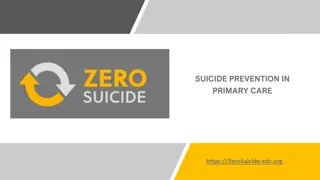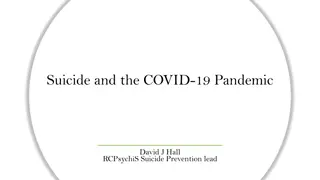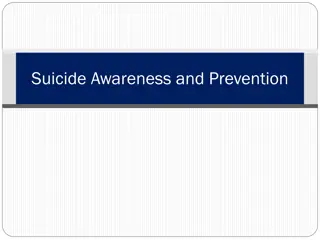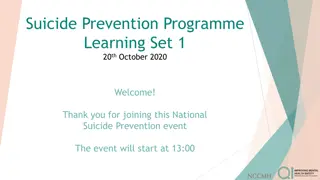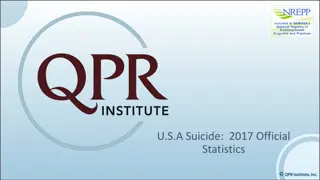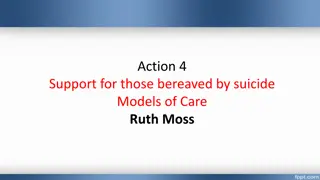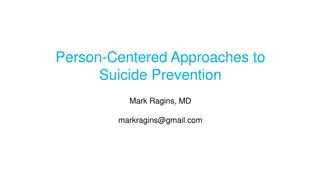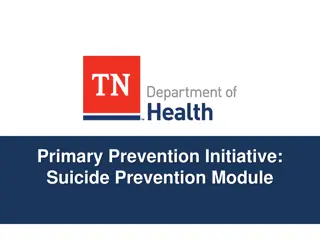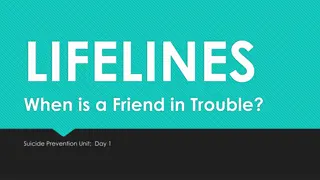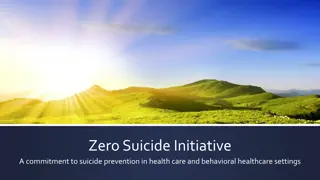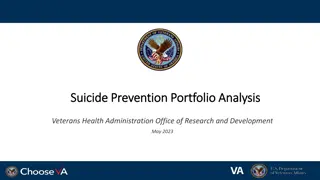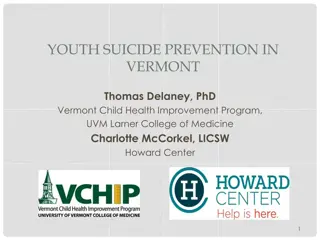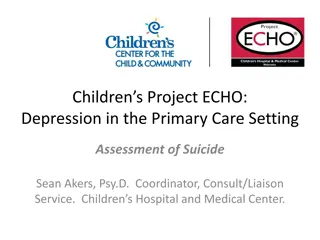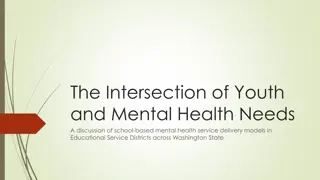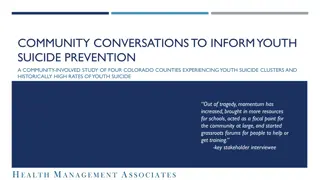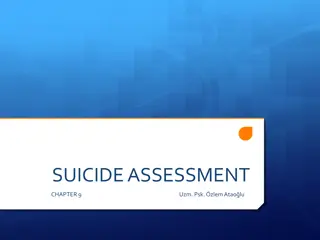Suicide Prevention and Intervention
Exploring the alarming statistics and factors related to suicide, this content delves into risk factors, warning signs, and protective measures. It emphasizes the importance of recognizing signals, accessing help, and fostering supportive relationships to prevent such tragedies. Resources for intervention and support are highlighted to equip individuals with practical knowledge in addressing mental health concerns.
Download Presentation

Please find below an Image/Link to download the presentation.
The content on the website is provided AS IS for your information and personal use only. It may not be sold, licensed, or shared on other websites without obtaining consent from the author.If you encounter any issues during the download, it is possible that the publisher has removed the file from their server.
You are allowed to download the files provided on this website for personal or commercial use, subject to the condition that they are used lawfully. All files are the property of their respective owners.
The content on the website is provided AS IS for your information and personal use only. It may not be sold, licensed, or shared on other websites without obtaining consent from the author.
E N D
Presentation Transcript
Suicide Prevention and Intervention
Prevention & Intervention: The Need Suicide is the 2ndleading cause of death for 10-14 year olds Suicide is the 3rdleading case of death for 15-24 year olds 15.8% of students surveyed in a national study, reported seriously considering suicide within the past 12 months 2016 Henry County Student Health Survey indicated that: ~10% of our high school students seriously considered suicide in the past year. ~8% of our middle school students seriously considered suicide in the past year
Objective To learn risk factors and warning signs for suicide To learn protective factors to prevent suicide To understand what to do and how to access help if you identify a student that may need intervention Learn some local and national resources dedicated to preventing suicide
Risk Factors vs. Warning Signs vs. Protective Factors Risk Factors Risk factors are characteristics that make it more likely that individuals will consider, attempt, or die by suicide Warning Signs Warning signs indicate an immediate risk of suicide Protective Factors Protective factors are characteristics that make it less likely that individuals will consider, attempt, or die by suicide
Examples of Risk, Warning, and Protective Factors for Heart Attack and Suicide
Risk Factors for Suicide Previous suicide attempts Alcohol and drug abuse Mental illness, including mood disorders, such as depression, anxiety disorders, and certain personality disorders Impulsive/Aggressive Tendencies Hopelessness History of Trauma or Abuse Family history of suicide LGBTQ+ Identification Adapted from Suicide Prevention Resource Center http://www.suicidepreventionlifeline.org/learn/riskfactors.aspx
If you notice risk factors for suicide Get help by contacting your school counselor, school social worker, or administrator. Continue to build a meaningful relationship with the student Increase protective factors that may save a child s life
Warning Signs for Suicidal Thoughts 4 out of 5 teens who attempt suicide give clear warning signs. Warning Signs of suicidal ideation include, but are not limited, to the following: Talking about suicide Talking about being a burden to others Making or writing statements about feeling hopeless, helpless, or worthless This may be contained in a writing prompt, assignment, or other form of written expression A deepening depression Preoccupation with death Taking unnecessary risks or exhibiting self-destructive behavior Out of character behavior A loss of interest in the things one cares about Visiting or calling people one cares about Making arrangements; setting one s affairs in order Giving prized possessions away
If you notice warning signs of suicidal thoughts Get help immediately by contacting your school counselor, school social worker, or administrator.
How Do Students Ask for Help? In dialogue with other students: Often, students will disclose their thoughts/plans with peers first Take all concerns from peers seriously Within written exercises, such as a writing prompt, literature assignment or other. In dialogue with teachers or other staff Non-verbal expressions during, before, or after the school day: Self-injury in itself is not always indicative of suicidal ideation, but there is a correlation between these two behaviors. Sudden change in behavior - withdrawn, angry, sad, giving things away Sense of or expression of hopelessness Suicide attempt student may disclose that they took a handful of pills before coming to school, or at school. Student may be actively attempting to cut or harm self at school with intention to die (Extreme Risk - Notify Administrator immediately for help/authorized to CALL 911 if needed)
Making a Referral for Suicide Assessment Designated student services personnel should be notified immediately to begin assessment process Students should be treated with compassion from start to end of referral/assessment process Students should be actively supervised at all times once identified: do not send students alone to counseling office do not allow them to sit alone in the media center while you are busy in a nearby office Share all information regarding the referral with the counselor, school social worker, or administrator. Do not assume the student will share with another adult.
Protective Factors Effective mental health care Connectedness to individuals, family, community, and social institutions Problem-solving skills Conflict resolution skills Social skills Impulse control Coping skills Hope for the future Reasons for living Supportive peers Contacts with caregivers research has shown that even postcards from providers to patients have demonstrated reductions in suicide
Creating Safe Spaces BE AVAILABLE FOR KIDS Encourage supportive communication and actions in the classroom Eliminate bullying behaviors and promote positive behaviors Have resources readily available (Suicide Prevention Line cards; SAMHSA SAFE T Cards) for students without them having to ask Place SAFE SPACE stickers in your office area, somewhere visible for students No Place for Hate activities creating an inclusive, supportive classroom environment Know which students struggle with depression, other mental illness Always be aware and actively identify students that need help All kids need to know that they matter to someone
Where to Get Help? Local Mobile Crisis Assessment National Suicide Prevention Lifeline
Where Can Students and Adults Get Help? Where Can Students and Adults Get Help? Local Crisis Assessment Resources: Local Crisis Assessment Resources: Assessment Facility Ages Served Phone Website Insurance Cost** Areas of Treatment Mobile Crisis Assessments - refers out for services Georgia Crisis and Access Line 1-800-715- 4225 www.mygcal.com All N/A Free All managed Medicaid, Peach State, Tri Care, most other private insurance Crescent Pines 1000 Eagles Landing Parkway Stockbridge, GA 30281 Crisis/Psychiatric Stabilization and treatment; Drug and alcohol dependency Free, but call first 770-474- 8888 www.crescentpineshospital.com 4 and up Crisis/Psychiatric Stabilization and treatment; Drug and alcohol treatment Riverwoods Hospital 11 Upper Riverdale Rd. Riverdale, GA Most private insurance; call for others 877-394- 5271 http://www.riverwoodsbehavioral.com/ 9 and up Free Peachstate, Wellcare, Amerigroup, most private, call for most current info Anchor Hospital 5454 Yorktown Dr. Atlanta, GA 30349 Crisis/Psychiatric stabilization and treatment. 770-991- 6044 www.anchorhospital.com 13 and up Free Crisis/Psychiatric stabilization and treatment. Treats clients with mild intellectual disabilities on case by case basis. Lakeview Behavioral Health 1 Technology Parkway Norcross, GA 30092 Most private insurance; call for others 877-659- 4522 http://www.lakeviewbehavioralhealth.com/ 9 and up Free Piedmont Henry Hospital ER 1133 Eagles Landing Pkwy Stockbridge, GA 30281 Based on ER fees 678-604- 1000 http://www.piedmont.org/locations/piedmont- henry/phh-home All Crisis assessment Peachford Hospital 251 Peachford Rd. Atlanta, GA 30338 Crisis/Psychiatric Stabilization and treatment 770-454- 2302 peachford,com 4 and up Free ***Crescent Pines is no longer a resource*** ***Crescent Pines is no longer a resource***
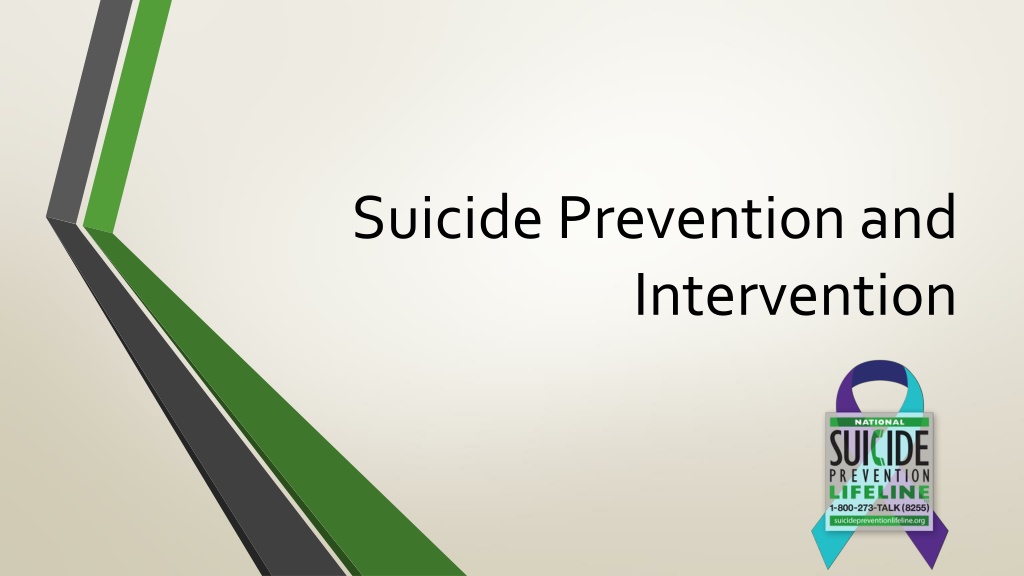
 undefined
undefined




